 |
 |
|||||||||||||
|
|||||||||||||
|
|||||||||||||
|
“Our superconducting technology group here at Cornell is doing some very fundamental R&D,” says Hasan Padamsee, physics professor at Cornell university and expert in superconducting rf technology. “Note that the stress is on the fun in fundamentals.” Students are even allowed to drill holes into cavity prototypes in order to find out what makes certain areas in the material behave differently from others. A new mapping technique, invented by Cornell's Don Hartill, Zach Conway and Eric Smith, could make it possible to locate quenches during cavity tests with just eight (instead of up to 180) thermometers. Superconducting cavities for the ILC won't have an easy life. They will be pushed to their limits constantly, forced to sweep the beams along towards the interaction point at high power to ensure the best possible physics results. Scientists must make sure now that they can take the power that will be pumped into them, and to do so they have to test the cavities — and test them again and again. They are looking for the perfect recipe to treat the material itself and the cavity surfaces because spots, blemishes or inclusions could cause a quench in the cavity. A quench is a sudden warming of the supercold superconducting cavity surface in a certain area where the current flowing through the cavity meets resistance and generates heat. The cavity field collapses and the acceleration gradient goes down, which means that the particles don't get up to the required energies. The cavities sit in a bath of superfluid liquid helium, and a special property of helium in the superfluid state is the key factor in the new technique proposed by Cornell. The heat generated by the quench does not propagate by diffusion, as one would expect; instead, in superfluid helium, the temperature propagates by a wave. This temperature wave is called "second sound" because it behaves just like a sound wave in air. That means that special 'temperature microphones' (they are actually called oscillating superleak transducers) can measure the heat burst and the scientists can triangulate the exact quench location from the response of a few sensors. “We know the time of flight and can locate the quench spot down to 5-millimetre precision,” explains Zach Conway. “We should be able to do it within one millimetre in the future.” Temperature mapping is a standard technique in cavity testing, but at the moment it requires between 10 and 20 thermometers per cell, which means up to 180 thermometers for a nine-cell cavity — not only a lot of work but also a lot of money and time. The team thinks that eight sensors, placed strategically around the cavity, will be enough for a full cavity quench test. The technique also allows the detection of quench spots in more than one cell in the same test by powering the nine pass-band modes of a 9-cell cavity. The new microphones are custom-made at Cornell, but the principle isn't new — it's been used in low-temperature physics for a while. “We have also used several standard thermometers on our nine-cell re-entrant cavity and proved that the predicted quench location from second sound detection was right. Now we're looking inside the cavity with a Questar telescope to find the fault,” adds Padamsee. Cornell will test all future cavities with these microphones and hopes other will do the same. -- Barbara Warmbein |
|||||||||||||
| © International Linear Collider |

